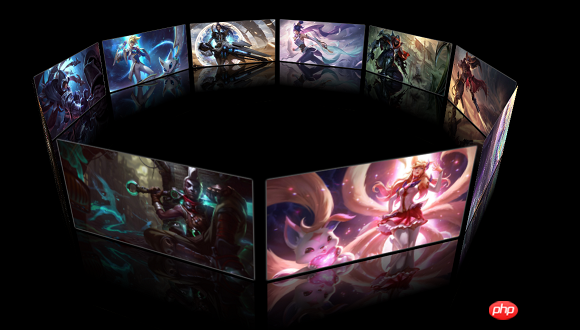How to implement a 3D photo wall with javascript (with code)
The content of this article is about how to implement a 3D photo wall with JavaScript (with code). It has certain reference value. Friends in need can refer to it. I hope it will be helpful to you.
The case I will share with you today is a cool 3D photo wall


This case is mainly through CSS3 and It is implemented using native JS. Next, I will share with you the process of achieving this effect. I don’t know how to put local videos on the blog, so I can only put two screenshots of the effects.
1. Realize static spread effect pictures
HTML content:
<div id="perspective">
<div id="wrap">
<img src="img2/1.jpg"></img>
<img src="img2/2.jpg"></img>
<img src="img2/3.jpg"></img>
<img src="img2/4.jpg"></img>
<img src="img2/5.jpg"></img>
<img src="img2/6.jpg"></img>
<img src="img2/7.jpg"></img>
<img src="img2/8.jpg"></img>
<img src="img2/9.jpg"></img>
<img src="img2/10.jpg"></img>
</div>
</div><style>
*{margin:0;padding: 0;}
body{background: #000;}
#perspective{perspective: 800px;}
#wrap{
width: 245px;
height: 125px;
border:1px solid red;
margin: 200px auto;
position: relative;
transform-style: preserve-3d;
transform: rotateX(-10deg)
}
#wrap img{
width: 100%;
height: 100%;
position: absolute;
left: 0;
top: 0;
border-radius: 1px;
box-shadow: 0 0 2px #fff;
}
</style>JS
<script>
var oWrap=document.getElementById("wrap");
var oImgs=oWrap.getElementsByTagName('img');
var deg=360/(oImgs.length);
for(var i=0;i<oImgs.length;i++){
oImgs[i].style.transform='rotateY('+i*deg+'deg) translateZ(400px)';
}
</script>There are several points to note in this part
(1) After positioning the image to the same div, set the transform-style attribute of the div to preserve-3d , and then place the picture along its y The axis rotates a certain angle. The sum of the rotation angles of these pictures must be 360 degrees, so as to form a circle; after the rotation angle, it is actually to change the z-axis direction of each picture (z The axis is always perpendicular to the picture), and then it can be displaced along the z-axis, which is equivalent to spreading the div, similar to a carousel in an amusement park. Finally, a scattered rendering will be formed.
(2) To build a 3D environment effect, mainly rely on transform-style in CSS3: preserve-3d;perspective:800px;here perspective The attribute is placed in the outer p so that when the div with the ID of wrap is rotated, it will not appear that the front picture is large and the back picture is small; it may be difficult to understand here, perspective It is the depth of the scene. After setting this attribute, the pictures in the back will look small and the pictures in the front will look big, similar to the big-ass TVs of the past. If the scene depth is placed in the p of wrap here, when rotating, it will be like rotating the entire TV instead of rotating the content in the scene.
2. Realize the rotation of the photo wall
The effect of this part is that when the mouse is pressed and moved, the photo wall will also rotate in the direction you move, and the faster you move, The faster it spins.
Implementation ideas:
(1) Determine the speed of movement based on the distance of the point change during mouse movement
(2) Can be obtained through the event parameter of the time function Event-related information
Event.clientX: Indicates the distance between the current mouse and the left side of the page
Event.clinetY: Indicates the distance between the current mouse and the top of the page
(3) Mouse During the movement, these two values will keep changing, so the photo wall can be rotated based on the difference between these two values. The larger the difference, the faster the rotation.
JS to realize rotation
<script>
var nowX,nowY,lastX,lastY,minusX,minusY;
var roX=-10,roY=0;
document.onmousedown=function(ev){
ev = ev || window.event;
lastX=ev.clientX;
lastY=ev.clientY;
this.onmousemove=function(ev){
ev = ev || window.event;
//当前鼠标距离页面左边的距离
nowX=ev.clientX;
//当前鼠标距离页面上边的距离
nowY=ev.clientY;
//X方向上的差值
minusX=nowX - lastX;
//Y方向上的差值
minusY=nowY - lastY;
//X轴的旋转角度(乘0.1是防止旋转过快)
roX-=minusY*0.1;
//y轴的旋转角度(乘0.2是防止旋转过快)
roY+=minusX*0.2;
oWrap.style.transform='rotateX('+roX+'deg) rotateY('+roY+'deg)';
lastX=nowX;
lastY=nowY;
}
this.onmouseup=function(){
//鼠标抬起,结束鼠标移动事件
this.onmousemove=null;
}
return false;
}
</script>3.CSS3 to realize reflection
<style>
#wrap img{
width: 100%;
height: 100%;
position: absolute;
left: 0;
top: 0;
border-radius: 1px;
box-shadow: 0 0 2px #fff;
-webkit-box-reflect: below 5px -webkit-linear-gradient(top,rgba(0,0,0,0) 40%,rgba(0,0,0,0.5) 100%);
}
</style>4.Rotation Inertia implementation
Idea: When the mouse is lifted, it rotates with a smaller and smaller value, implemented through a timer
JS implementation of inertia
timer=setInterval(function(){
minusX*=0.95;
minusY*=0.95;
roY+=minusX*0.2;
roX-=minusY*0.1;
oWrap.style.transform='rotateX('+roX+'deg) rotateY('+roY+'deg)';
if(Math.abs(minusX)<0.5 && Math.abs(minusY)<0.5){
clearInterval(timer);
}
},13)In Add the above code to the onmouseup event function.
5. Add entrance animation
The last picture comes out first, the first picture comes out last, the transform animation is delayed accordingly, and the JS code is modified as follows

The above is a rough description of this case.
The above is the detailed content of How to implement a 3D photo wall with javascript (with code). For more information, please follow other related articles on the PHP Chinese website!

Hot AI Tools

Undresser.AI Undress
AI-powered app for creating realistic nude photos

AI Clothes Remover
Online AI tool for removing clothes from photos.

Undress AI Tool
Undress images for free

Clothoff.io
AI clothes remover

Video Face Swap
Swap faces in any video effortlessly with our completely free AI face swap tool!

Hot Article

Hot Tools

Notepad++7.3.1
Easy-to-use and free code editor

SublimeText3 Chinese version
Chinese version, very easy to use

Zend Studio 13.0.1
Powerful PHP integrated development environment

Dreamweaver CS6
Visual web development tools

SublimeText3 Mac version
God-level code editing software (SublimeText3)

Hot Topics
 1386
1386
 52
52
 How to implement an online speech recognition system using WebSocket and JavaScript
Dec 17, 2023 pm 02:54 PM
How to implement an online speech recognition system using WebSocket and JavaScript
Dec 17, 2023 pm 02:54 PM
How to use WebSocket and JavaScript to implement an online speech recognition system Introduction: With the continuous development of technology, speech recognition technology has become an important part of the field of artificial intelligence. The online speech recognition system based on WebSocket and JavaScript has the characteristics of low latency, real-time and cross-platform, and has become a widely used solution. This article will introduce how to use WebSocket and JavaScript to implement an online speech recognition system.
 WebSocket and JavaScript: key technologies for implementing real-time monitoring systems
Dec 17, 2023 pm 05:30 PM
WebSocket and JavaScript: key technologies for implementing real-time monitoring systems
Dec 17, 2023 pm 05:30 PM
WebSocket and JavaScript: Key technologies for realizing real-time monitoring systems Introduction: With the rapid development of Internet technology, real-time monitoring systems have been widely used in various fields. One of the key technologies to achieve real-time monitoring is the combination of WebSocket and JavaScript. This article will introduce the application of WebSocket and JavaScript in real-time monitoring systems, give code examples, and explain their implementation principles in detail. 1. WebSocket technology
 How to use JavaScript and WebSocket to implement a real-time online ordering system
Dec 17, 2023 pm 12:09 PM
How to use JavaScript and WebSocket to implement a real-time online ordering system
Dec 17, 2023 pm 12:09 PM
Introduction to how to use JavaScript and WebSocket to implement a real-time online ordering system: With the popularity of the Internet and the advancement of technology, more and more restaurants have begun to provide online ordering services. In order to implement a real-time online ordering system, we can use JavaScript and WebSocket technology. WebSocket is a full-duplex communication protocol based on the TCP protocol, which can realize real-time two-way communication between the client and the server. In the real-time online ordering system, when the user selects dishes and places an order
 How to implement an online reservation system using WebSocket and JavaScript
Dec 17, 2023 am 09:39 AM
How to implement an online reservation system using WebSocket and JavaScript
Dec 17, 2023 am 09:39 AM
How to use WebSocket and JavaScript to implement an online reservation system. In today's digital era, more and more businesses and services need to provide online reservation functions. It is crucial to implement an efficient and real-time online reservation system. This article will introduce how to use WebSocket and JavaScript to implement an online reservation system, and provide specific code examples. 1. What is WebSocket? WebSocket is a full-duplex method on a single TCP connection.
 JavaScript and WebSocket: Building an efficient real-time weather forecasting system
Dec 17, 2023 pm 05:13 PM
JavaScript and WebSocket: Building an efficient real-time weather forecasting system
Dec 17, 2023 pm 05:13 PM
JavaScript and WebSocket: Building an efficient real-time weather forecast system Introduction: Today, the accuracy of weather forecasts is of great significance to daily life and decision-making. As technology develops, we can provide more accurate and reliable weather forecasts by obtaining weather data in real time. In this article, we will learn how to use JavaScript and WebSocket technology to build an efficient real-time weather forecast system. This article will demonstrate the implementation process through specific code examples. We
 Simple JavaScript Tutorial: How to Get HTTP Status Code
Jan 05, 2024 pm 06:08 PM
Simple JavaScript Tutorial: How to Get HTTP Status Code
Jan 05, 2024 pm 06:08 PM
JavaScript tutorial: How to get HTTP status code, specific code examples are required. Preface: In web development, data interaction with the server is often involved. When communicating with the server, we often need to obtain the returned HTTP status code to determine whether the operation is successful, and perform corresponding processing based on different status codes. This article will teach you how to use JavaScript to obtain HTTP status codes and provide some practical code examples. Using XMLHttpRequest
 How to use insertBefore in javascript
Nov 24, 2023 am 11:56 AM
How to use insertBefore in javascript
Nov 24, 2023 am 11:56 AM
Usage: In JavaScript, the insertBefore() method is used to insert a new node in the DOM tree. This method requires two parameters: the new node to be inserted and the reference node (that is, the node where the new node will be inserted).
 JavaScript and WebSocket: Building an efficient real-time image processing system
Dec 17, 2023 am 08:41 AM
JavaScript and WebSocket: Building an efficient real-time image processing system
Dec 17, 2023 am 08:41 AM
JavaScript is a programming language widely used in web development, while WebSocket is a network protocol used for real-time communication. Combining the powerful functions of the two, we can create an efficient real-time image processing system. This article will introduce how to implement this system using JavaScript and WebSocket, and provide specific code examples. First, we need to clarify the requirements and goals of the real-time image processing system. Suppose we have a camera device that can collect real-time image data




